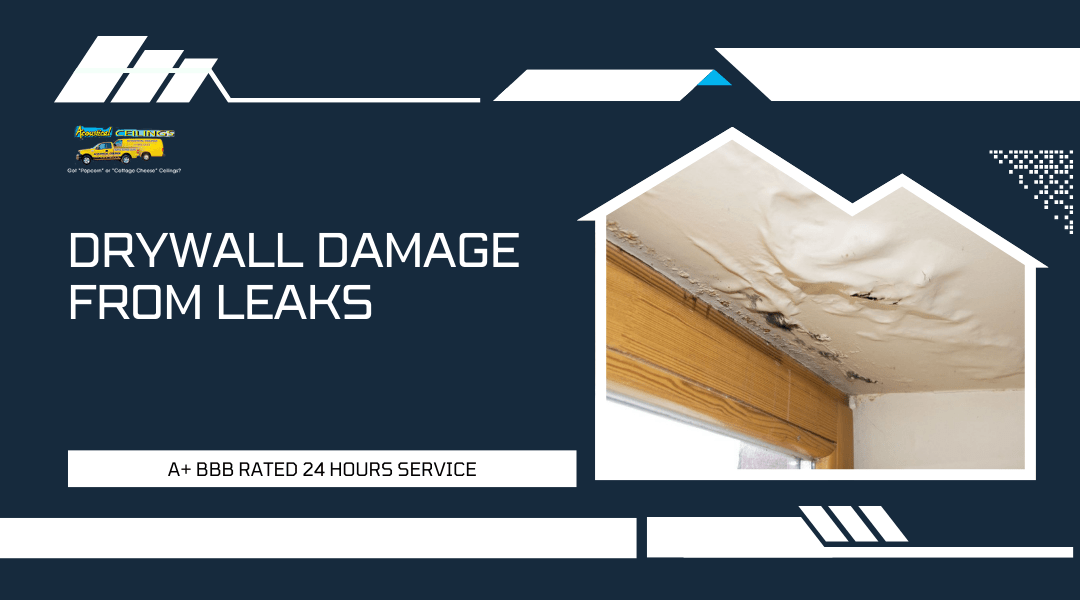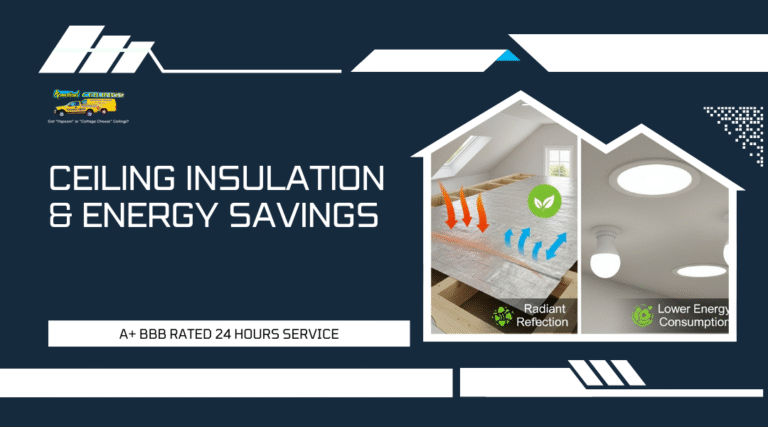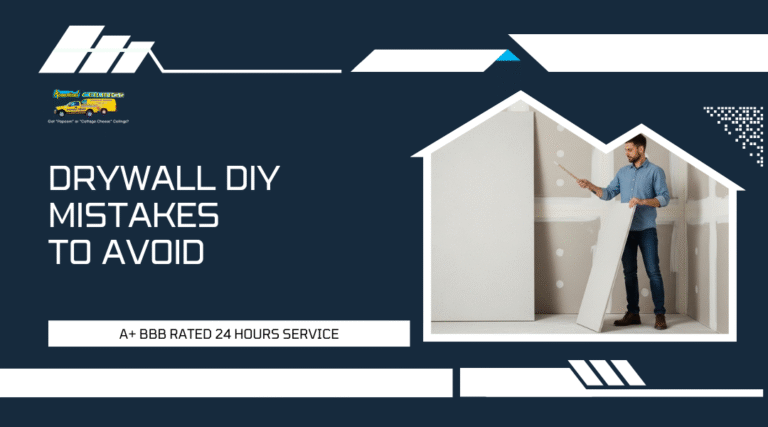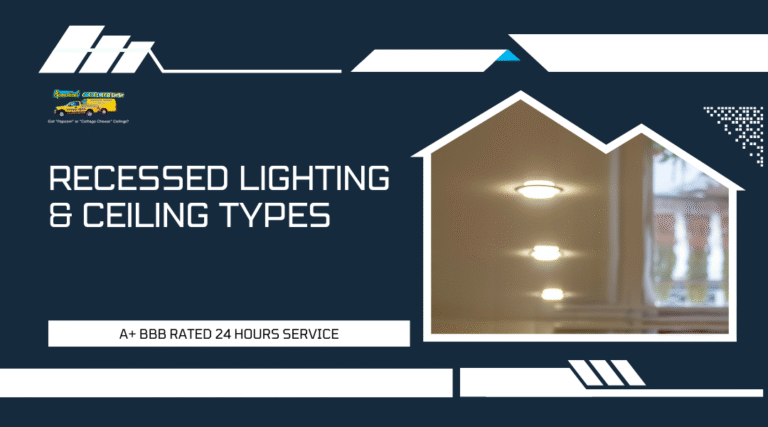Water leaks in your home can quickly turn from a minor nuisance into a major structural concern when they affect your drywall. The porous nature of drywall makes it particularly vulnerable to moisture, which can lead to swelling, discoloration, and create the perfect environment for mold growth.
Identifying and addressing drywall damage from leaks promptly can prevent costly structural repairs and protect your family’s health from potential mold exposure. What starts as a small stain or soft spot can escalate into sagging ceilings, warped walls, and extensive mold remediation needs if left untreated.
Understanding the warning signs, knowing when to repair versus replace damaged sections, and taking preventive measures will help you protect your investment and maintain a safe living environment. The key is recognizing that visible damage often indicates larger underlying issues that require professional assessment and proper remediation.
Why Leaks Cause Serious Drywall Damage
Water infiltration creates a cascade of problems that compromise drywall integrity within hours. Multiple sources of moisture combine with drywall’s porous composition to create extensive structural damage that often remains hidden until serious deterioration occurs.
How Water Interacts With Drywall
Drywall contains gypsum core material that absorbs water rapidly. When moisture penetrates the surface, it weakens the chemical bonds holding the material together.
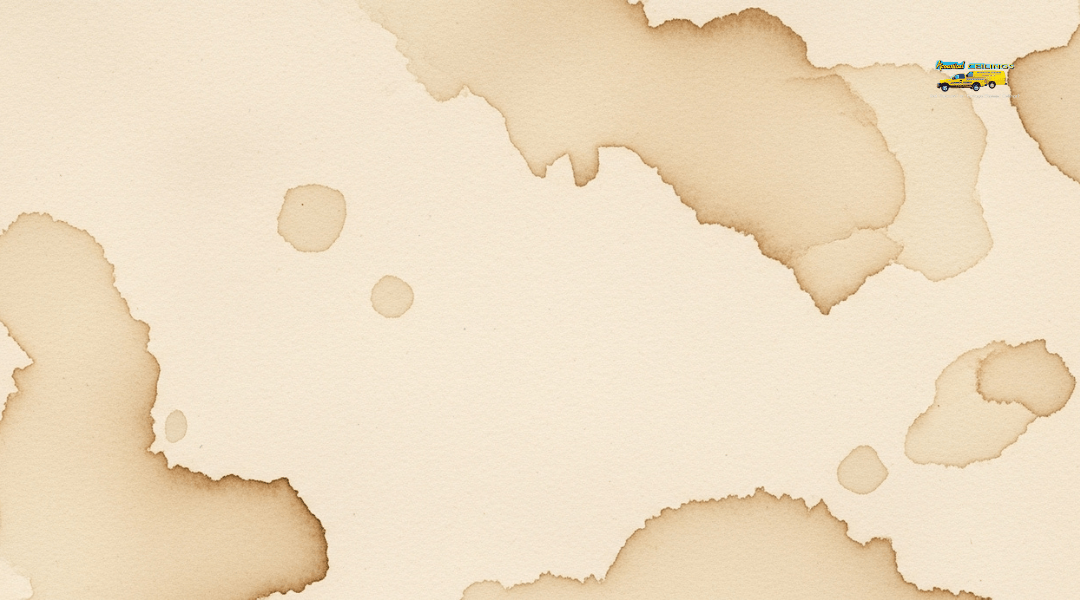
Your drywall begins deteriorating within 24-48 hours of water exposure. The paper facing becomes soft and starts separating from the gypsum core.
Water damage progresses through these stages:
- Initial absorption: Surface discoloration appears
- Structural weakening: Material becomes soft and crumbly
- Delamination: Paper facing peels away from core
- Complete failure: Sections sag or collapse entirely
The gypsum core expands when wet, creating permanent warping. Even after drying, your drywall maintains this distorted shape and reduced strength.
Temperature and humidity accelerate damage. Warm conditions speed absorption while high humidity prevents proper drying.
Common Sources Of Leaks In Rancho Cucamonga Homes
Roof leaks represent the primary source of drywall damage in your area. Heavy winter rains and occasional snow create multiple failure points.
Common roof problems include:
- Damaged shingles from wind exposure
- Clogged gutters causing water backup
- Flashing deterioration around chimneys
- Ice dam formation during cold snaps
Plumbing leaks cause concentrated damage behind walls. Your supply lines experience pressure fluctuations that stress joints and connections.
Kitchen and bathroom areas face higher risk from:
- Toilet seal failures
- Shower pan leaks
- Supply line ruptures
- Drain pipe blockages
HVAC condensation creates ongoing moisture problems. Your air conditioning system produces substantial condensation during cooling seasons.
Foundation issues allow groundwater infiltration. Clay soil expansion puts pressure on basement walls, creating cracks that permit water entry.
Signs Of Hidden Moisture Damage
Visual indicators appear before structural failure occurs. Brown or yellow staining signals active water infiltration in your walls.
Watch for these warning signs:
- Bubbling or peeling paint
- Sagging ceiling sections
- Soft spots when pressed
- Hairline cracks appearing suddenly
Musty odors indicate mold growth within wall cavities. This smell becomes noticeable 48-72 hours after initial water exposure.
Temperature differences reveal moisture accumulation. Wet drywall feels cooler than surrounding dry areas.
Your electrical outlets may show corrosion or discoloration. Water tracking down inside walls reaches electrical boxes first.
Texture changes become apparent through touch. Damaged drywall loses its firm consistency and feels spongy or crumbly.
The Risks Of Ignoring Drywall Damage
Water-damaged drywall creates serious problems that extend beyond visible stains and discoloration. Delaying repairs can compromise your home’s structural integrity, create dangerous health conditions, and significantly reduce your property’s market value.
Structural Weakness And Safety Concerns
Water-damaged drywall loses its structural integrity when moisture saturates the gypsum core. The material becomes soft and crumbly, unable to support its own weight or maintain proper attachment to wall studs.
Saturated drywall can collapse without warning. This poses immediate safety risks to anyone in the affected area. The weight of wet drywall often causes sections to fall unexpectedly.
Key structural risks include:
- Wall sagging and bowing
- Complete panel failure
- Compromised electrical systems
- Damaged insulation behind walls
Water damage often extends beyond the drywall itself. Moisture can weaken wooden framing members, causing rot in wall studs and support beams. This type of structural damage requires extensive reconstruction work.
Your home’s electrical systems face serious risks when water penetrates drywall. Moisture can reach wiring and outlets, creating fire hazards and electrocution dangers.
Mold Growth And Health Hazards
Mold growth begins within 24 to 48 hours when water-damaged drywall remains untreated. The paper backing and gypsum core provide ideal food sources for mold spores in moist environments.
Common health symptoms from mold exposure:
- Respiratory problems
- Skin irritation
- Eye irritation
- Allergic reactions
- Asthma complications
Certain mold types produce mycotoxins that cause severe health problems. Black mold (Stachybotrys chartarum) creates particularly dangerous toxins that affect the nervous system and immune function.
Mold spreads rapidly through your home’s air circulation system. Spores travel through HVAC ducts, contaminating rooms far from the original water damage site. This makes remediation more complex and expensive.
Children and elderly individuals face higher risks from mold exposure. Their immune systems cannot fight off mold-related illnesses as effectively as healthy adults.
Long-Term Property Value Impact
Water damage and mold problems create lasting effects on your home’s market value. Potential buyers often reject properties with any history of water damage or mold issues.
Real estate disclosures require you to report past water damage and mold problems. This transparency reduces buyer interest and forces price reductions to attract offers.
Financial consequences include:
- 10-25% reduction in property value
- Extended time on market
- Required professional inspections
- Mandatory remediation before sale
Insurance claims for water damage create permanent records that follow your property. Future buyers may face higher insurance premiums or coverage limitations due to your home’s damage history.
Banks and mortgage lenders often require additional inspections for properties with water damage history. These requirements can complicate or prevent sales to qualified buyers.
The cost of delayed repairs always exceeds immediate action. What starts as a simple drywall replacement can become a full room renovation requiring new flooring, electrical work, and HVAC cleaning.
How To Identify Drywall Damage From Leaks
Early detection of leak-related drywall damage prevents costly repairs and health hazards. Look for visual changes like stains and bubbling, use your senses to detect moisture, and recognize when professional assessment becomes necessary.
Visual Signs: Stains, Bubbling, And Cracks
Water stains appear as brown, yellow, or rust-colored patches on walls and ceilings. These marks indicate active or previous leaks from plumbing or roofing issues.
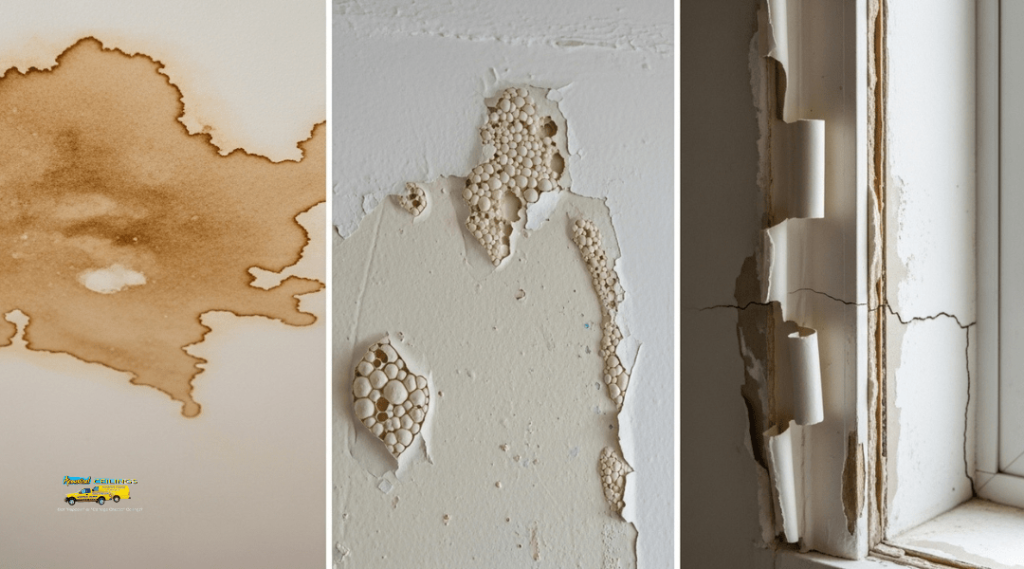
Discoloration extends beyond obvious stains. You may notice subtle color changes where drywall has absorbed moisture over time.
Paint problems manifest in several ways:
- Bubbling or blistering paint that loses adhesion
- Peeling paint that flakes off in strips
- Warped or curling paint edges
Surface irregularities signal structural damage. Sagging drywall feels soft when pressed and creates uneven wall surfaces. Bulging sections indicate water accumulation behind the drywall.
Crack patterns develop around moisture-damaged areas. These cracks typically appear near joints, corners, or around fixtures where water penetration occurs most frequently.
Smell And Touch Indicators Of Moisture
A musty odor indicates mold growth behind drywall surfaces. This smell becomes more pronounced in humid conditions or after rain.
Touch tests reveal hidden damage. Press gently on suspected areas – water-damaged drywall feels spongy or soft compared to dry sections.
Temperature differences help identify problem areas. Moisture-affected drywall often feels cooler to the touch than surrounding dry areas.
Check for dampness by placing your hand near the wall surface. You may detect increased humidity levels around damaged sections.
Listen for hollow sounds when tapping walls. Water damage can change the acoustic properties of drywall, creating different sound patterns.
When To Call A Professional Inspection
Extensive damage requires professional assessment. Call experts when water stains cover large areas or multiple rooms show signs of moisture intrusion.
Health concerns warrant immediate professional intervention. If you detect strong musty odors or see visible mold growth, professionals can safely assess and remediate the situation.
Hidden damage needs specialized detection. Professionals use moisture meters and thermal imaging to identify problems behind wall surfaces that visual inspection cannot reveal.
Recurring issues indicate systemic problems. If stains reappear after cleaning or repairs, professionals can identify underlying leak sources and structural damage.
Insurance claims benefit from professional documentation. Expert assessments provide detailed damage reports needed for insurance coverage and repair estimates.
Repair Vs. Replacement: What’s The Right Approach?
The extent of water damage determines whether you need simple patching or complete panel replacement. Minor surface damage often requires only basic repair techniques, while severe water penetration demands full drywall replacement to prevent structural issues and mold growth.
Minor Patching For Surface-Level Damage
Small water stains and minor surface damage can often be resolved through targeted drywall repair. This approach works when the leak was brief and didn’t penetrate deeply into the drywall material.
Signs that patching will work:
- Water stains without soft spots
- Surface discoloration only
- No visible mold growth
- Drywall feels firm when pressed
You can handle minor repairs with spackle or joint compound for small areas. Sand the damaged area smooth once dry, then apply primer to block any remaining stains.
Tools needed:
- Putty knife
- Fine-grit sandpaper
- Stain-blocking primer
- Matching paint
The repair process typically takes 2-3 days when accounting for drying time. Minor patching costs between $20-50 in materials for most homeowners.
This method only works if you’ve already fixed the source of the leak. Attempting repairs while moisture issues persist will lead to recurring damage.
Full Panel Replacement For Severe Leaks
Extensive water damage requires complete drywall replacement to ensure structural integrity. Severe leaks compromise the gypsum core, making the material weak and prone to mold growth.
Replace drywall when you see:
- Soft or crumbling areas
- Sagging sections
- Brown or black mold spots
- Musty odors from the wall
Water damage restoration professionals typically recommend replacement when more than 30% of a panel shows damage. The affected drywall must be cut out and removed completely.
Professional water damage repair ensures proper moisture detection behind walls. Contractors use moisture meters to identify hidden wet areas that could cause future problems.
Replacement process includes:
- Cutting out damaged sections
- Checking insulation and framing
- Installing new drywall panels
- Taping and finishing joints
Severe damage often extends beyond visible areas. Professional assessment prevents incomplete repairs that allow mold growth in wall cavities.
Cost Considerations For Rancho Cucamonga Property Owners
Material costs for drywall replacement typically range from $1.50 to $3.00 per square foot. Labor adds another $2.00 to $4.00 per square foot depending on the complexity.
| Repair Type | Material Cost | Labor Cost | Total Range |
|---|---|---|---|
| Minor Patch | $20-50 | $100-200 | $120-250 |
| Panel Replacement | $50-150 | $300-600 | $350-750 |
Additional costs to consider:
- Mold remediation: $500-1,500
- Insulation replacement: $2-4 per sq ft
- Texture matching: $150-300
Professional water damage restoration often costs less than DIY mistakes. Incomplete repairs lead to recurring issues that multiply expenses over time.
Insurance coverage varies for leak damage depending on the cause. Sudden pipe bursts typically receive coverage, while gradual leaks from poor maintenance may not qualify.
Getting multiple quotes helps you compare pricing and scope of work. Reputable contractors provide detailed estimates that break down materials and labor costs separately.
Preventing Future Drywall Damage
Preventing water damage to drywall requires consistent maintenance of key home systems and controlling moisture levels throughout your property. Regular inspections, proper ventilation, and strategic waterproofing create multiple barriers against water intrusion.
Routine Roof, Plumbing, And HVAC Maintenance
Your home’s water systems need regular attention to prevent leaks that damage drywall. Check plumbing fixtures monthly for signs of moisture, corrosion, or dripping.
Inspect visible pipes in basements, crawl spaces, and under sinks quarterly. Look for water stains, mineral deposits, or rust that indicate slow leaks.
Roof maintenance checklist:
- Clear clogged gutters every 3-6 months
- Check downspouts for proper drainage away from foundation
- Inspect flashing around chimneys and vents annually
- Replace damaged or missing shingles promptly
HVAC systems can cause water damage through condensation and drain line issues. Change filters regularly to maintain proper airflow and prevent ice buildup on coils.
Clean condensate drain lines annually to prevent backups. Check ductwork in unconditioned spaces for condensation problems that can drip onto drywall below.
Proper Ventilation And Moisture Control
High humidity creates conditions for water damage even without visible leaks. Maintain indoor humidity between 30-50% using dehumidifiers when necessary.
Install exhaust fans in bathrooms and kitchens to remove moisture at the source. Run bathroom fans for 30 minutes after showers to eliminate excess humidity.
Key ventilation strategies:
- Use range hoods while cooking
- Open windows when weather permits
- Ensure attic and crawl space ventilation
- Check that dryer vents exhaust outside
Monitor problem areas like basements and bathrooms with humidity meters. Address condensation on windows immediately as it indicates excess moisture that can affect nearby drywall.
Proactive Waterproofing Measures
Install waterproof drywall in moisture-prone areas before problems develop. Green board or cement board provides better protection in bathrooms and basements than standard drywall.
Seal gaps around windows, doors, and penetrations where water can enter wall cavities. Use appropriate caulks and weatherstripping for different materials and locations.
Waterproofing priorities:
- Apply vapor barriers in basements
- Seal foundation cracks promptly
- Install water leak detectors near appliances
- Maintain proper grading around your home’s foundation
Consider whole-house water leak detection systems that shut off main water supply when leaks occur. These devices provide 24-hour protection against major water damage events.
Why Choose Acoustical Ceilings For Drywall Repair In Rancho Cucamonga
Acoustical Ceilings brings five decades of specialized experience to water damage restoration projects throughout Rancho Cucamonga and San Bernardino County. Their established reputation and comprehensive approach make them a reliable choice for addressing leak-related drywall issues.
Local Expertise With Water-Damaged Drywall
Acoustical Ceilings has served the Rancho Cucamonga area since 1968, giving them extensive knowledge of local building materials and common water damage patterns. Their team understands how Southern California’s climate affects drywall repair and restoration processes.
The company specializes in water damage repair as one of their core services. They can assess whether your damaged drywall needs simple repairs or complete replacement based on the extent of moisture penetration.
Their decades of experience mean they’ve encountered virtually every type of water damage scenario. From minor ceiling stains to extensive flooding damage, they know how to properly address moisture-related issues.
Key water damage services include:
- Assessment of repair vs. replacement needs
- Moisture detection and elimination
- Mold prevention techniques
- Structural integrity evaluation
Commitment To Quality Materials And Techniques
The company maintains high standards for both materials and installation methods. Their 40+ years of combined experience ensures they use proven techniques for lasting repairs.
Acoustical Ceilings follows strict procedures when working with water-damaged areas. They protect your property during repairs and use appropriate safety measures throughout the restoration process.
Their comprehensive approach addresses both visible damage and underlying issues. This includes proper moisture elimination before repairs begin and ensuring complete drywall restoration.
Their quality approach includes:
- Professional assessment of damage extent
- Proper moisture removal before repairs
- High-grade materials for lasting results
- Seamless repairs that match existing surfaces
Trusted By Homeowners And Businesses In Rancho Cucamonga
Acoustical Ceilings maintains an A+ rating with the Better Business Bureau, demonstrating their commitment to customer satisfaction. This rating reflects their consistent delivery of quality work and professional service.
The company offers 24-hour service availability, which proves valuable during water damage emergencies. Quick response times can prevent minor leaks from becoming major restoration projects.
Their family-owned business model emphasizes long-term relationships with customers. Many clients return for additional projects, indicating satisfaction with previous work quality.
Customer reviews consistently highlight their professionalism and reasonable pricing. Their established presence at 9531 Tryon Street in Rancho Cucamonga makes them easily accessible for local consultations and estimates.

